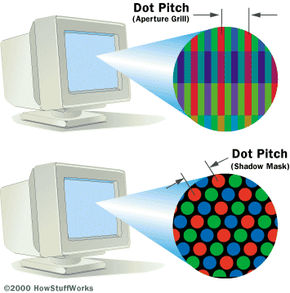The dot pitch rating of a monitor tells you just how sharp the displayed image will be. Dot pitch is measured in millimeters (mm), and a smaller number means a sharper image. How you measure the dot pitch depends on the technology used.
- In most CRTs you measure dot pitch as the distance between holes in the shadow mask. The shadow mask is a metal screen filled with holes through which the three electron beams pass that focus to a single point on the tube's phosphor surface.
- Monitors based on the Trinitron technology, developed by Sony, use an aperture grill instead of a shadow mask. The aperture grill consists of tiny vertical wires. The dot pitch of one of these monitors is measured by the horizontal distance between wires.
- In LCDs and the majority of other display technologies, dot pitch refers to the distance between subpixels of the same color in pixel triads.
In computer displays, common dot pitches are .31mm, .28mm, .27mm, .26mm, and .25mm. Traditional televisions often use a larger dot pitch, about .51 mm, and large screen TVs or projection devices can go up to 1 millimeter in pitch.
Advertisement
The smaller and closer the dots are to one another, the more realistic and detailed the picture appears. When the dots are farther apart, they become noticeable and make the image look grainier. You will usually want a .28mm or finer. Anything larger than that on a typical monitor will begin to appear grainy.
The dot pitch translates directly to the resolution on the screen. If you were to put a ruler up to the glass and measure an inch, you would see a certain number of dots, depending on the dot pitch. See below for the number of dots per square centimeter and per square inch in each of these dot pitches:
Advertisement
